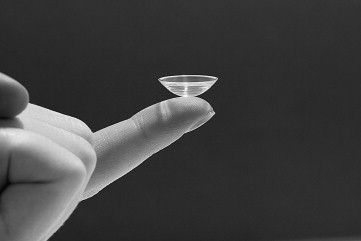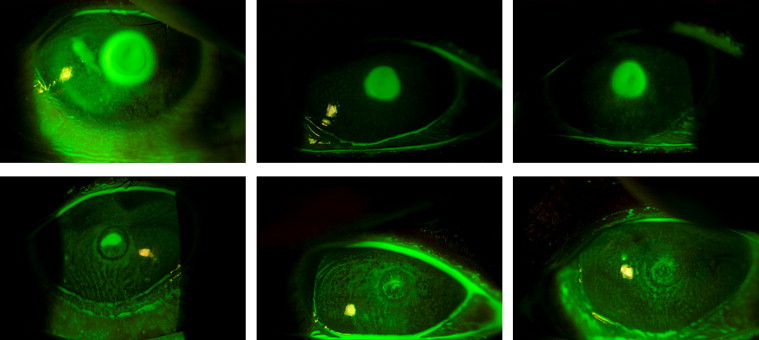Purpose
To report experience in the treatment of persistent corneal epithelial defect using overnight wear of a prosthetic device for the ocular surface.
Design
Retrospective interventional case series.
Methods
A clinical database of patients who underwent prosthetic replacement of the ocular surface ecosystem (PROSE) treatment from March 2003 to August 2008 was searched to identify patients treated for persistent corneal epithelial defect. In early 2003, overnight wear of a PROSE device and addition of commercially available, nonpreserved, topical ophthalmic moxifloxacin to the saline in the device reservoir became standard practice at this center when treating persistent corneal epithelial defect. Medical records were abstracted to obtain underlying diagnoses, previous treatments, days to re-epithelialization, and complications for subsequent analysis.
Results
PROSE treatment incorporating overnight wear, with adjunctive use of moxifloxacin, was employed in 20 eyes of 19 patients for a total of 372 days. Re-epithelialization occurred in 17 of 20 eyes. Median duration of treatment incorporating overnight wear was 8.5 days (range = 2-76 days). Healing occurred in ≤7 days in 12 eyes, 8-14 days in 3 eyes, and >14 days in 2 eyes (range = 1-35 days). There were no cases of microbial keratitis.
Conclusions
Overnight wear of a PROSE device is effective in promoting healing of persistent corneal epithelial defect. In comparison to an earlier series from this center, the rate of microbial keratitis as a complication of treatment has been reduced with the use of a nonpreserved topical fourth-generation fluoroquinolone in the device reservoir.
Persistent corneal epithelial defect occurs when conditions such as exposure, limbal stem cell deficiency, dry eye syndrome, diabetes, or neurotrophic keratitis interfere with normal functions of the ocular surface. Persistent corneal epithelial defect can result in corneal haze, infectious and sterile keratitis, stromal melting, perforation, irregular astigmatism, loss of vision, and loss of the eye. Interventions for persistent corneal epithelial defect typically include topical lubricants, patching, punctal occlusion, soft contact lenses, tarsorrhaphy, topical autologous serum, and amniotic membrane grafting.
Prosthetic replacement of the ocular surface ecosystem (PROSE) is a treatment that uses custom-designed and custom-fabricated prosthetic devices to replace or augment the impaired ocular surface functions in complex corneal disease. A PROSE device ( Figure 1 ), because of its high oxygen permeability, fluid-filled reservoir, lack of corneal contact, positional stability on the eye, and protection from lid-related shear forces, creates an environment that supports healing and maintenance of the corneal surface. A 2000 report from this center (Boston Foundation for Sight, Needham, Massachusetts, USA) described 4 cases of microbial keratitis among 14 cases of persistent corneal epithelial defect treated with extended wear of a PROSE device. This infection rate suggested that the benefits of off-label overnight wear may not outweigh the risks. With a combination of heightened awareness of potential preservative toxicity, a standardized medical approach using both daytime and overnight wear with daily monitoring and cleaning, and the prophylactic use of a commercially available, nonpreserved fourth- generation fluoroquinolone, we observed clinical effectiveness with an apparent reduction in infections. To better characterize our experience, we conducted a retrospective review of an interventional case series of all eyes that underwent PROSE treatment for persistent corneal epithelial defect at this center in the time period immediately following the introduction of a nonpreserved fourth-generation fluoroquinolone to our treatment regimen.

Methods
Western Institutional Review Board (IRB) prospectively determined that this retrospective medical record review of an interventional case series was exempt from IRB review under 45 CFR 46.101(b)(4). This study was conducted in accordance with HIPAA, the Declaration of Helsinki guidelines, and all applicable federal and state laws. A clinical database of patients undergoing PROSE treatment at the Boston Foundation for Sight, Needham, Massachusetts, from March 2003 to August 2008 was used to identify patients with a diagnosis of persistent corneal epithelial defect. PROSE treatment took place from August 2003 through May 2008. Retrospective chart review was conducted. Underlying diagnoses, previous treatments, days of PROSE treatment, days to re-epithelialization, and complications were extracted and analyzed.
For each patient, a PROSE device was designed, manufactured, and fitted as previously described. Patients were examined by specially trained physicians who used custom computer-aided-design software to directly specify the parameters of PROSE devices customized for the eye being treated. These design specifications were then used to control device fabrication. Multiple devices were created for each eye as part of the fitting process, with the observed clinical performance of each device guiding the design of the next. The final device, having optimal fit and optical characteristics, was dispensed to the patient for long-term use. PROSE device insertion, removal, and cleaning were done by experienced personnel until patients gained device-handling competence through a course of supervised training. Because re-epithelialization time was variable and long-term maintenance would require self-care, we did not necessarily wait for epithelial healing before initiating patient training.
PROSE device wear was generally instituted at the time of the initial consultation. A PROSE device was worn continuously, both day and night, except for 1-2 brief periods each day when the device was removed for cleaning and replacement of the reservoir fluid. Devices were cleaned with Boston Cleaner (Polymer Technology Corporation, Rochester, New York, USA), rinsed with nonpreserved sterile saline, and conditioned with Boston Conditioning Solution (Polymer Technology Corporation). Prior to each application of the PROSE device to the eye, 1 drop of ophthalmic moxifloxacin, commercially available in nonpreserved formulation (Alcon, Fort Worth, Texas, USA), was placed in the device reservoir. The reservoir was then topped off with sterile, nonpreserved saline. Any other topical medications required by each patient were instilled during the intervals when the PROSE device was removed for cleaning. The size of the persistent corneal epithelial defect was monitored with slit-lamp photography at each visit.
Results
Twenty eyes from 19 patients met inclusion criteria ( Table ). Age ranged from 7-83 years old (mean = 48.55 years, SD = 20.51). Male-to-female ratio was 12:8. Diagnoses in order of decreasing frequency were ocular graft-vs-host disease (7/20), neurotrophic keratopathy (5/20), limbal stem cell deficiency (4/20), Stevens-Johnson syndrome (2/20), keratoconjunctivitis sicca (1/20), and ectrodactyly–ectodermal dysplasia–cleft palate (EEC) syndrome (1/20). Eight eyes had a history of penetrating keratoplasty. Prior treatments for persistent corneal epithelial defect included artificial tears, topical ointments, bandage contact lenses, topical cyclosporine 0.05%, topical autologous serum, punctal occlusion, amniotic membrane grafts, and tarsorrhaphy.
| Case | Sex | Age | Primary Diagnosis | Duration of PCED (Days) | PCED Size at Presentation (mm) | Prior Treatment for PCED a | Days to Heal (Episode # if Recurrent) | Complications | Total Days of PROSE Treatment (Using Day-and-Night Wear) | Result (Episode # if Recurrent) |
|---|---|---|---|---|---|---|---|---|---|---|
| Healed | ||||||||||
| 1 | M | 58 | GVHD | 7 | 4 × 4 | 1,5 | 7 | None | 7 | Healed |
| 2 | M | 55 | GVHD | 18 | IR | 1,2,7 | 35 | None | 35 | Healed |
| 3 | M | 40 | GVHD | 31 | 1.5 × 2.5 | 1,3 | 1 | None | 8 | Healed |
| 4 | M | 43 | GVHD | IR | 2 × 2 | 1,2,3,4 | 6 | None | 7 | Healed |
| 5 | F | 64 | GVHD | 4 | 11 × 9.5 | 1 | (#1): Did not heal (#2): 43 | #1: Corneal graft leak #2: None | 29 | (#1): Graft wound leak requiring revision (#2): Healed |
| 6 | M | 40 | GVHD | IR | 3 × 3 | 1,2,3 | 7 | None | 8 | Healed |
| 7 | F | 33 | SJS | IR | 3.5 × 3 | 1,2,5 | 13 | None | 16 | Healed |
| 8 | M | 49 | SJS | IR | 12 × 9 | 1,5,7 | (#1): 20 (#2): IR | None | 36 | (#1): Healed (#2): Healed (per report) |
| 9A | M | 37 | SJS | 14 | 6 × 5 | 3,5,6 | (#1): 6 (#2): 4 (#3): 2 (#4): IR | None | 76 | (#1): Healed (#2): Healed (#3): Healed (#4): Healed (per report) |
| 9B | M | 37 | SJS | 14 | 4 × 4 | 3,5,6 | (#1): 5 (#2): 1 | None | 42 | (#1): Healed (#2): Healed |
| 10 | F | 73 | HZO NTK | IR | 8.5 × 5 | 4,7 | 5 | None | 7 | Healed |
| 11 | F | 62 | NTK | 28 | 3 × 3 | 5 | 5 | None | 16 | Healed |
| 12 | M | 12 | NTK | 19 | 5 × 2 | 1,3,4,6 | 6 | None | 6 | Healed |
| 13 | F | 7 | Congenital NTK | IR | 1.2 × 2.4 | 1,3,7 | 1 | None | 2 | Healed |
| 14 | M | 35 | LSCD | 60 | 6 × 1.2 | 3,5 | 7 | None | 2 | Healed |
| 15 | M | 76 | LSCD | 30 | 2 × 4.4 | 5 | 14 | None | 8 | Healed |
| 16 | F | 83 | KCS | IR | 3.2 × 2.4 | 1,2,3,5 | 2 | None | 2 | Healed |
| Not healed | ||||||||||
| 17 | M | 62 | GVHD | IR | 9.6 × 7.2 | 1,2 | Did not heal | None | 45 | Did not heal → Patient died of systemic disease |
| 18 | F | 77 | HZO NTK | IR | 3.8 × 2.9 | 1,2,3,7 | Did not heal | None | 13 | Did not heal → Tarsorrhaphy |
| 19 | F | 40 | EEC | 90 | 4.8 × 5.8 | 1,5,6,7 | Did not heal | Corneal perforation | 9 | Corneal melt/perforation → PK + tarsorrhaphy |
a Prior treatments coded as follows: 1 = topical lubricants; 2 = topical cyclosporine; 3 = punctal occlusion; 4 = topical autologous serum; 5 = bandage contact lens; 6 = amniotic membrane grafting; 7 = tarsorrhaphy.
The persistent corneal epithelial defect healed in 17 of 20 eyes. Within this group of seventeen eyes, healing of the initial persistent corneal epithelial defect occurred in ≤7 days in 12 eyes, 8-14 days in 2 eyes, and >14 days in 3 eyes (range = 1-43 days).
Three of the eyes had recurrences of the persistent corneal epithelial defect (Cases 8, 9A, and 9B). In each of these cases, the initial corneal epithelial defect healed with day-and-night wear of a PROSE device but recurred upon transition to daytime-only wear. Resuming day-and-night wear again resulted in healing, but long-term maintenance required a more gradual taper to daytime-only wear. In each case the defect remained healed at the last follow-up. The mean follow-up period from initial to last visit at the Boston Foundation for Sight was 302 days (range = 9-1439 days, SD = 397 days).
Case Reports
Case 6 was a 39-year-old man with ocular graft-vs-host disease after stem cell transplant for acute myelogenous leukemia ( Figure 2 ). He presented with a sterile ulcer and persistent corneal epithelial defect in the left eye that was refractory to frequent artificial tears, topical cyclosporine 0.05% twice daily, and punctal plugs. Presenting visual acuity was 20/400 (pinhole 20/40). The surface re-epithelialized after 7 days of PROSE day-and-night wear. The regimen was changed to daytime-only wear after day 8. The patient achieved a best-corrected visual acuity of 20/20-3 without recurrences or complications.


Stay updated, free articles. Join our Telegram channel

Full access? Get Clinical Tree


